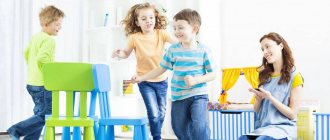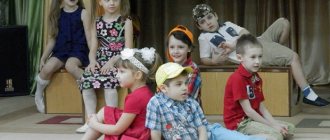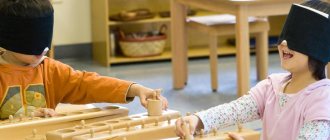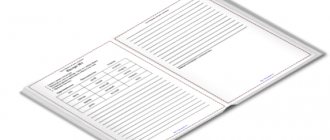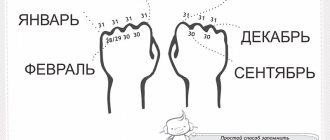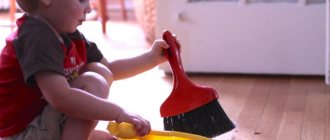When a child turns 3 years old, both parents and the baby themselves face tremendous changes. This is the famous crisis of three years, and a possible acquaintance with kindergarten, and for the first time truly meaningful behavior.
The pace of development of children is individual. Some three-year-olds already speak fluently, show interest in learning and strive for complete independence. Other children at the same age do not develop as actively, but this is not a deviation at all. However, there are general standards for what a 3-year-old child should be able to do. And if you are worried about whether your baby is developing in a timely manner, follow these standards and, most likely, you will make sure that everything is fine with your child!
Content:
- Basic skills of a child at 3 years old
- Physical development: main indicators Height and weight
- Physical skills
- Motor skills
Basic skills of a child at 3 years old
What a child should be able to do at the age of three - basic standards:
- understand simple cause-and-effect relationships, for example, “fell in a puddle - got dirty”;
- begin to strive for independence: try to dress yourself or with minimal help from an adult;
- actively expand your vocabulary, use complex sentences in speech, for example: “We didn’t go for a walk because it was raining outside”;
- know the basic colors and the words that these colors represent;
- recognize obstacles in the area - for example, steps, curbs - and overcome them;
- be able to show emotions and control emotions, show empathy;
- understand the meaning of the words “mine” or “his/her”
- play role-playing games - for example, “teacher-student”, “doctor-patient”.
Games for 3-4 year old children to develop basic skills
English lessons for children 1-2 years old
Educational outdoor games house
1. Game “Overcome obstacles.” Build obstacles from toys, cubes, bottles, toys. The kid must overcome these obstacles and come to the start. If you have a bicycle at home, you can go through obstacles on a bicycle or scooter.
2. Dance games for children 3-4 years old
These games will be a real boon for the holidays with children. Also, if other children come to visit you, you can organize such games. Children love to have fun and dance, dance in circles.
"Pretend to be a monkey." The kids stand in a circle, with an adult leader standing in the center of the circle. The presenter shows the movements, and the children must repeat after him as accurately as possible.
Physical development: main indicators
The physical development of a child is assessed according to three main criteria: height and weight, physical abilities, and motor skills.
Height and weight
The height and weight of two children at the age of three can differ significantly - these physical parameters depend on hereditary factors and, to a lesser extent, on the child's gender and lifestyle. In pediatrics, the “golden mean” for the weight of a three-year-old is considered to be 15 kilograms, for height - 95 centimeters .
If your baby’s height is 10% less than the standard 95 centimeters, this is not a cause for concern, but, most likely, a personal developmental feature. But if your son or daughter’s height at 3 years is less than 85 centimeters, you should think about eliminating negative factors: try to adjust the baby’s diet and organize reasonable physical activity for the child, after consulting with a doctor.
In the weight parameters for a three-year-old child, deviations of 20% are allowed in both directions from 15 kilograms. If the baby’s weight is less than 12 or more than 18 kilograms, you may need to reconsider the diet, taking into account the recommendations of pediatricians.
Physical skills
Basic physical skills of a three-year-old:
- knows the terrain well enough, remembers familiar routes;
- draws and makes simple appliqués himself;
- knows how to ride a tricycle:
- claps his hands and stomps his feet well;
- With the help of his parents, he assembles quite complex construction sets, and also puts together multi-part puzzles with outside help.
Motor skills
By the age of three, the child’s motor activity develops noticeably even compared to the period of several months preceding the third birthday. Basic motor skills of a child at three years old:
- maintains balance while standing on one leg;
- climbs and descends stairs without assistance;
- plays various ball games;
- runs, rarely stumbling and falling;
- repeats simple dance movements: jumps, rises on tiptoes.
Sports
Physical development is as important for a baby as intellectual development. This is due to the fact that when the child goes to school, he will not only have physical education lessons, in which he must complete all the tasks for agility, strength and endurance, but also outdoor games with classmates during breaks. if for some reason the child is unable to take part in them, then the number of his possible friends risks being reduced.
Every morning, start with simple exercises, including exercises to warm up your muscles, stretching and the obligatory light jogging.
Kids love sports activities very much.
If you have a daughter, then include a variety of dances in the program - usually little ones like them, while boys prefer ball games and jumping.
Be sure to use exercise equipment: jump ropes, a variety of balls, children's dumbbells, bright hoops and gymnastic mats - all this will help the child perform the exercise with greater quality and pleasure, while reducing the risk of injury.
leave a comment
Development of fine motor skills
The fine motor skills of a three-year-old are becoming more and more perfect. The child develops previous skills and acquires new ones:
- enjoys repeating finger gymnastics exercises;
- reinforces speech with gestures, and if the baby is emotional, gestures can be very active;
- builds buildings of different sizes and configurations from cubes;
- learns to use scissors and can cut out simple shapes from paper;
- knows how to sculpt simple structures from plasticine: flagella, balls;
- confidently grasps and holds objects;
- opens loose caps on bottles.
Changing clothes
Dressing up is a kind of ritual of turning into another person, trying on not just someone else’s clothes, but new character traits. A very useful activity from a psychological point of view. There is another advantage in such a game - the development of taste, sense of style, and the ability to harmoniously select accessories. Agree, it will be very useful in life. Why not teach this from childhood? Moreover, both boys and girls will be happy to look at themselves in the mirror and come up with new images.
sobitie.com.ua
Another option is to arrange a funny home photo shoot, print postcards and give them to relatives.
Development of hearing, vision, touch, taste
The hearing of three-year-old children requires especially careful attention. At this age, children often catch colds, which can lead to otitis media and, as a consequence, hearing impairment.
In order not to harm your child’s hearing, be sure to teach him to breathe through his nose and not his mouth, treat a runny nose in a timely manner and try to avoid sudden changes in temperature.
The vision of three-year-old children is not yet sharp enough compared to children of older preschool age. Vision is fully formed only by 6-7 years. You should not try to teach your child to read as early as possible - children's vision is ready for reading only at the age of five . Of course, you can show books to a three-year-old, but the books must use large font. To preserve fragile children's vision, reduce your child's contact with the phone, computer, and TV.
At 3 years old, children’s sense of touch is well developed: they distinguish between cold and hot water, warm and cold wind, rough and smooth surfaces. The taste buds of a three-year-old child are developed in the same way as those of an adult. It distinguishes between sweet, bitter, sour and salty tastes, preferring sweets.
Game No. 1 “Learning to count” (for kids 3-4 years old)
DESCRIPTION: An educational positive game that will make counting fun and interesting. With such a game you can play with your child at any free moment. You can print these pictures in advance and play at any time!
Attention! How to copy coloring pictures from our website?
- Choose any picture. Right-click on the picture.
- Select "Save Image As". Save it in a convenient folder and print it from there!
Norms of speech development
A three-year-old child already has a fairly rich vocabulary: at least 1000 words. The clarity of speech at this age is not yet impeccable: the baby may distort words and have difficulty pronouncing individual sounds correctly. A three-year-old is already able to reason in a simple form about an object or event he saw.
A 3-year-old child does not speak or speaks little: what to do?
At three years old, a child’s speech skills are sufficiently developed to be able to communicate with other people. Normally, by the age of three years, a child has the following speech skills:
- understands the questions asked and answers them;
- knows his first and last name well;
- speech becomes coherent, resembling a story: one sentence follows from another;
- describes the picture he saw, paying attention to details;
- retells short tales and stories.
Children who speak almost or not at all by the age of three are quite common. The famous Russian pediatrician Evgeniy Komarovsky advises parents whose children at 3 years of age do not yet speak to pay attention to the type of stubborn silence: is the child silent because he does not understand the speech of those around him, or does the baby understand everything, but says nothing?
If a child shows signs of understanding without using words, perhaps silence is his personal trait. Three-year-old silent children, according to pediatrician statistics, are more common among boys—for every one non-talking girl, there are four such boys. According to the same statistics, at least 7% of children aged three years do not speak at all.
In any case, if a three-year-old child does not speak at all, you need to visit a pediatrician with him. Based on the examination results, the doctor will recommend ways to solve the problem or refer you to specialized specialists.
Crisis of three years
The three-year crisis is considered the most turbulent in a child’s development, and it is a serious obstacle to regular developmental activities. Negativism, hysterics, stubbornness, ignoring requests, jealousy - you can encounter all this at any time. What to do in this case?
- Change your tactics and ignore the hysteria.
- Give your child more time to recover.
- Provide choice, or the illusion of it.
- Instead of forcing your child, offer help.
- Don't criticize or scold.
If you feel that you cannot cope with yourself and your child, seek the help of child psychologists and early development teachers. Most likely, in an unfamiliar environment the child will begin to behave more calmly. Classes in early development centers are held in small groups of up to 6 people, where children feel comfortable and receive a lot of attention.
Date of publication: 09/24/2018. Last modified: 01/13/2020.
Communication skills and emotional sphere
A three-year-old child needs to communicate with peers more than before. The child is already learning to manage emotions and trying to resolve conflicts peacefully. At the same time, the three-year-old feels an urgent need to express his “I”, which leads to capricious behavior towards parents and other close people. Closer to four years, the child begins to understand other people's emotions, learns to control himself and excessive whims disappear.
The emotional sphere of three-year-old children is actively developing: they begin to fantasize. The guys with the richest imagination even surprise others with stories of their own creation. Normally, an emotionally developed child at 3 years old strives to repeat the actions he likes after other people, and knows how to express likes and dislikes.
Mental development
Along with the crisis of three years comes the age of “why”. The child asks adults about everything in the world, compares the answers, and draws conclusions.
The pace of mental development in different children may differ depending on the child’s personal abilities and the involvement of adults in the development process. Intellectual development at the age of three is considered normal if the child can:
- distinguish 4-8 colors;
- examine the object not only as a whole, but also notice details;
- do not be distracted too often, concentrate on one activity;
- make simple plans, for example: “in the morning we will go to kindergarten, and in the evening you will take me home”;
- count to five;
- find answers to children's riddles;
- operate with the concepts of “more-less” and find other differences between objects;
- memorize simple poems and songs;
- distinguish basic geometric shapes from each other - circle, triangle, rectangle, square - and name them.
Fun game 3 for memory development “To the Store” (all children’s favorite game)
Children love to play and play in the store.
The game develops auditory short-term memory
Description: Send your child to the store, ask him to remember everything he needs to buy. Start with 2 purchases, increasing their number to 4-5. Name objects from feminine use for girls, and masculine items for boys. It will be more interesting to play this way.
- Switch roles.
- Make toy money for the game.
- How to remember everything? For example, buy a chocolate bar, loaf, cookies, milk, sour cream? It’s better to eat sour cream with milk, we’ll buy chocolate for the baby, we eat soup with a loaf of bread, and dad loves cookies. Use your associations and it will be even more interesting to play.
Intellectual games for children 3-4 years old
- “Set the table.” The game will teach the baby to help his mother and also count. Moreover, you will have fun. Ask your child to help set the table, bring two spoons and forks for mom and dad, bring apples, etc.
- "Fold a square." Ten multi-colored squares of cardboard - each cut in random order. The kid must reconstruct and count how many pieces each figure consists of.
- "Autumn leaf fall." Collect different leaves during your walk. Trace their outline on paper. Then the baby must guess where which piece of paper is depicted, without attaching the last one to the drawing.
- “Correct the mistake.” Using pre-prepared “wrong” pictures, the child is asked to figure out what’s wrong with them. For example, a blue bear cub pecks at grains, the child must notice that bears have a different color, and this animal does not feast on grains.
- Educational game to expand vocabulary baby
A fun game "Tell me which one?" Explain to your child that each object has signs, do it in a positive way. For example, an apple is round, red, big, sweet. Put different objects in the box and invite the child to take them out one by one and name the signs. You can even make up a fairy tale using these items.
- “Who can do what?” A 3-year-old child already knows many animals, birds, and professions. Give him an animal or a profession, and he must say what this object can do.
Role-playing games for children 3-4 years old
- "Daughters and mothers."
- "Holiday". Prepare for a birthday together. Make surprise gifts for dad or grandma. Children happily prepare gifts for birthday people, help set the table, and then begin the main delicacy.
- "Home construction". A plot that allows you to expand your child’s horizons with knowledge about construction equipment and professions. The little ones are involved in the process of creating a beautiful interior and home comfort, the boys try on the role of the head of the family.
Cognitive development
Children's cognitive skills include the development of perception, attention, memory, and thinking. The speed of cognitive development is influenced by the child’s exploration of the world around him: the more the baby interacts with different objects and the more he observes different phenomena, the better his cognitive abilities develop.
It is important for three-year-old children to experience the world in practice, which is why it is so important to reinforce the child’s personal experience with explanations from an adult. For example, explain the difference between opposing concepts (“narrow path - wide road”), encourage the child’s desire to analyze situations and events, and focus on specific details of objects.
At the age of three years, a child, with the help of perception, forms an idea of the properties of objects. He learns to compare the sizes and shapes of objects, knows the purpose of different things and uses them correctly.
The baby's attention becomes stable: he focuses on an interesting activity for 10-20 minutes, does not let several objects out of his sight at the same time. But a three-year-old can still get distracted quite easily.
Memory at three years of age is involuntary: a child remembers information that is interesting to him, but it is not yet easy for a child to learn something specifically.
Although the child can already establish cause-and-effect relationships, his thinking is still limited to the present time. A three-year-old child evaluates the situation “here and now,” but as the child learns about the world, his ability to analyze gradually develops. At the age of 3, children especially clearly feel the joy of a discoverer, and the more events that happen around the young explorer, the better his thinking develops .
Games for developing memory and attention
We have selected the top 5 games that can be played everywhere! They do not require special items or toys. Play at home, on the street, in the store!
Game 1 “Magic Word”
Goals: development of attention; mastering the rules of etiquette.
Description: the child must listen carefully to what the adult said and fulfill the request only if the adult said the word “please.”
For example: an adult says “Jump!” - the child should not react to words.
If an adult said “Sit on the sofa, please,” “Bring a book, please,” then the child must sit down, bring a book, etc., fulfill the request, since the word “please” was said.
Game 2 “I’ll tell you, and you remember”
Goal: to develop memory, attention, observation.
Description: a very simple game that perfectly develops memory in children 3-4 years old. Invite your child to repeat the items you listed. Start with a small number of items. The first few times, group items by type - furniture, toys, fruits, vegetables. In the future, you can increase the number of objects, add objects from other semantic categories: sofa, table, chair, doll, cup, ball, etc.
Independence, self-care skills
Young children are not yet able to take care of themselves completely, but by the age of three, the child should already have some self-service skills:
- undress and dress with little assistance;
- put on shoes or at least try to put on shoes on your own;
- wash your face and brush your teeth;
- use cutlery;
- fulfill simple everyday requests: put away toys, put things in their place, put a cup on the table.
Daily routine and care for a three-year-old child
The baby becomes very active, and it is important to adhere to a daily routine so that the child has enough strength. Of course, the routine of a child who goes to kindergarten will differ from the routine of a child who does not attend preschool, but an approximate daily routine for three-year-olds could be like this:
| 07.00 | Climb |
| 07.30 | Hygiene procedures, exercise |
| 08.00 | Breakfast |
| 08.30 | Educational games and activities, help with everyday life |
| 10.00 | Walk |
| 12.00 | Dinner |
| 12.30 | Daytime nap |
| 15.00 | Awakening |
| 15.30 | Afternoon snack |
| 16.00 | Outdoor and educational games |
| 18.00 | Walk |
| 19.00 | Dinner |
| 19.30 | Quiet activities |
| 20.30 | Hygiene procedures |
| 21.00 | Night sleep |
⠀
How to determine the developmental delay of a child at 3 years old?
Signs that may indicate problems with the baby's development:
- he is not interested in communication - neither with adults nor with other children;
- does not play with toys, does not show curiosity about unfamiliar objects;
- does not even recognize familiar objects;
- cannot even minimally control the expression of emotions;
- does not understand the speech of others.
If you notice similar signs in your child, contact your pediatrician.
Bubble
novate.ru
Soap bubbles are loved by children of all ages. They can be used at home, or combined with bathing. In the article Do-it-yourself soap bubbles: recipes and tips, we dwelt in detail on mixtures and devices for blowing soap bubbles yourself.
After studying the article Top 10 tricks with soap bubbles for children, you can organize a soap show without leaving your apartment.
www.youtube.com
Give your child a place where he can play with soapy liquid without fear - and he will be occupied for at least 15-20 minutes. You can first cover the floor with oilcloth or move to a tiled floor so that you can easily clean everything up later.
How to help a child develop correctly?
It is possible and necessary to help a three-year-old child develop - despite the desire for independence, children at this age willingly accept help from adults. Especially if this help is presented in the form of a game.
How to help three-year-old children develop important skills and abilities in accordance with the recommendations of teachers:
- Ask your child to tell you in detail how his day went. This technique trains memory better than special educational games.
- Resist in offering help. The less outside help, the faster the three-year-old will learn independence.
- Use your fingers to learn to count within five, and a little later - up to ten.
- In toys, give preference to pyramids, cubes, puzzles - they perfectly develop the skills of attentiveness, perseverance and spatial thinking.
- If there are no health contraindications, introduce your son or daughter to sports. Swimming is especially suitable - a universal way to maintain health, form beautiful posture, and strengthen all muscle groups.
Do not worry about the development and safety of your child, especially when he is away from you or home. Three years and going to kindergarten is a great reason to buy your baby his first GPS watch. With them and the “Where are my children” application, you will always know where your child is and what is happening around him.
Games
Play is the most important activity for a three-year-old child. At this age, the child enjoys the process exclusively, without setting a goal to learn new things. But parents can offer their son or daughter games that will help children's development.
Examples of educational games for three years:
- Games with water. Kids love to be in contact with water - help your little ones create their own water world. You can include bowls, glasses, a colander, and a spray bottle in the game and show how to play with water using these items. Water games develop imagination, coordination, and fine motor skills.
- Finger games. Classes with elements of finger gymnastics, like no other, develop fine motor skills.
- Modeling from plasticine or salt dough. Modeling helps develop creativity and fine motor skills.
- Games with cubes of different shapes and sizes. While building with cubes, reaction speed develops, the baby remembers colors and shapes, learns to compare objects and masters counting.
- Puzzles and mosaics. Starting with simple options, move on to more complex ones with more details. Puzzles and mosaics develop the ability to concentrate, develop imagination and fine motor skills.
Another feature of this period of child development is the three-year crisis. It is not simple. But you need to survive it, showing patience and helping the baby develop. And when the difficulties are left behind, the child will become an excellent conversationalist, play partner and best friend for his parents!
A moment of creativity
There are many ways to entertain your baby at home. The following options will appeal to creative children. They require perseverance and help from parents. You can offer your little one the following activities:
- Make something from scrap materials.
Every housewife will find some cereals, coffee beans and other things at home. All this will come in handy. You also need PVA glue and imagination.
You can make a vase from the prepared materials. For this you need a glass bottle with a wide neck or a glass. The container is greased with glue from the outside, then cereals, grains and everything that has been prepared are carefully poured onto its surface. You can make patterns on the vase.
- Many children love cutting paper. So why not turn it into a fun activity. The baby can be given the opportunity to cut out everything he likes from the provided magazines and pictures and paste it on his poster.
It is worth paying attention to the choice of scissors. They should have rounded ends so that the baby does not get hurt.
- In addition to cutting out ready-made pictures, you can give your baby the opportunity to make an applique on their own from colored cardboard and paper. Of course, he can’t cope without the help of his parents, but what an interesting activity this is that can unite the whole family.
